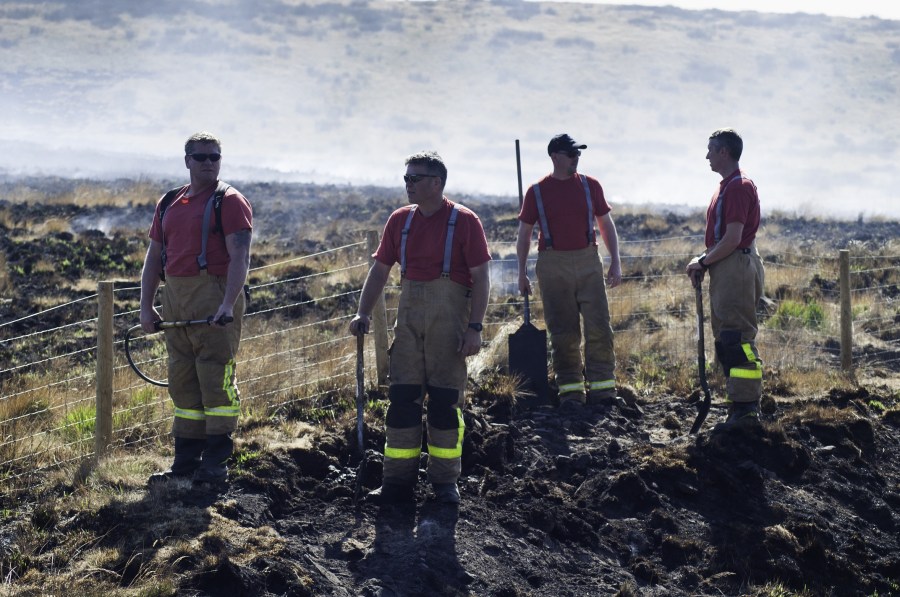Today’s rain might finally signal the end of the vast wildfires that blazed above Manchester and Bolton since late June. Andrew Galloway recently visited one of the sites to assess the impact on the moors and their local wildlife
Words and photos: Andrew Galloway
The website rainchester.com was set up by blogger Kam Cheng as a bit of a joke, Kam having been shocked by the amount and regularity of precipitation in the city when he moved there from Derbyshire some years ago. The site simply takes information from various weather reporting sites and displays a figure indicating the number of days since it last rained in the city. Last weekend, the figure stood at 17 days, the last rain having fallen on Manchester on the summer solstice.
At around 8pm on Sunday 24 June a fire was spotted on Saddleworth Moor to the east of Manchester. Fire crews in attendance brought the fire under control but strong winds on the Monday re-ignited the fire causing it to spread rapidly across the moor. By Wednesday the fire covered an area of 6km and was being attended by over 50 firefighters.
On the afternoon of Thursday 28 June, a separate moorland fire broke out on Winter Hill above the Rivington Terraced Gardens, an area of historic parkland to the north-west of Bolton. Crews from both the Greater Manchester and Lancashire Fire & Rescue Service were quick to attend and the blaze was initially brought under control, as had been the case at Saddleworth. However, on the following day a separate fire broke out on moorland further to the east. Fanned by strong winds, both fires rapidly spread out across the moor, eventually merging into a single blaze, declared a ‘major incident’ by police and fire services. The moorland fires continued to rage for several days until the emergency services were able to contain the progress of the fires at moorland boundaries, thus starving them of fuel.
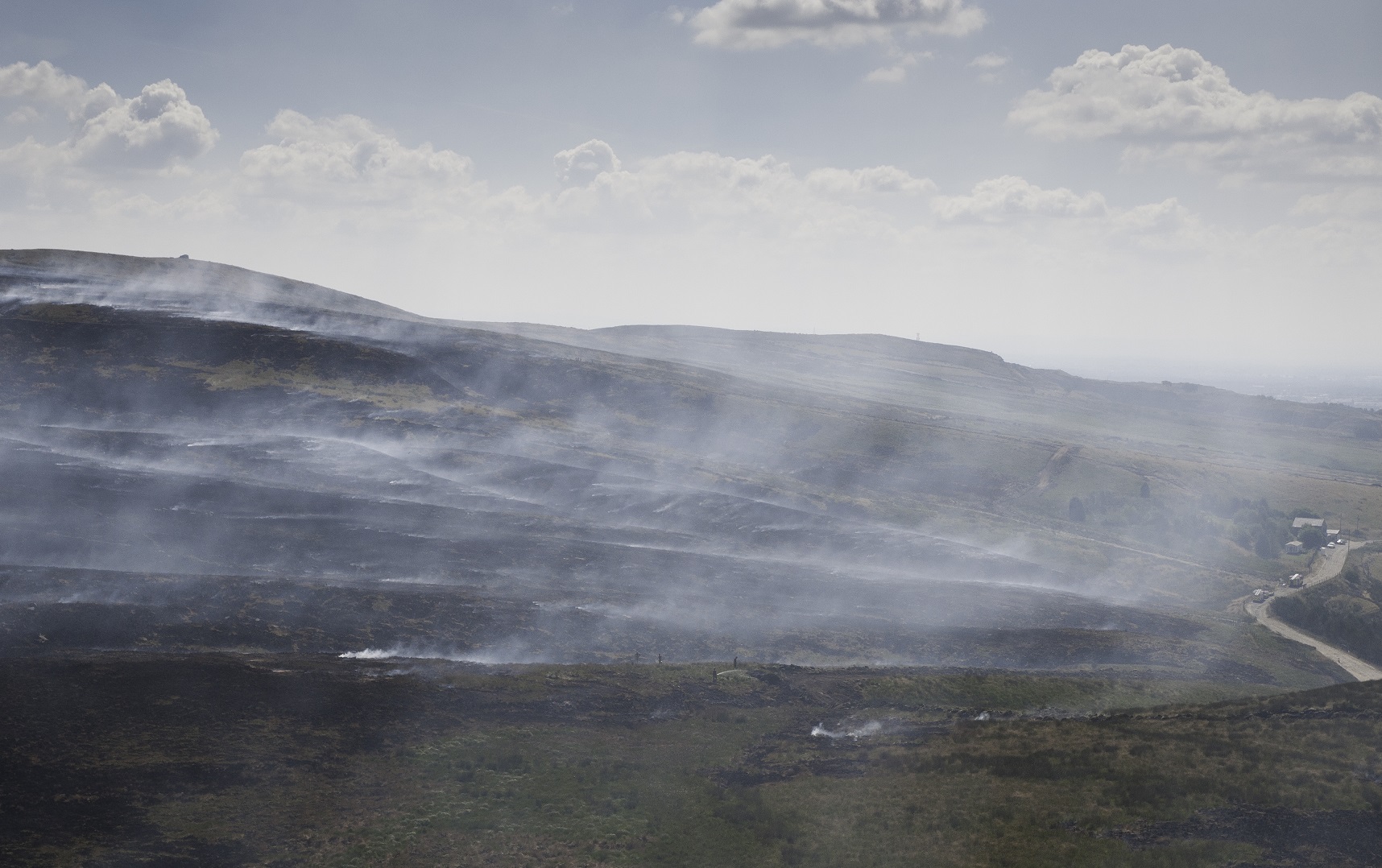 Lancashire Fire & Rescue Service tackling a hot spot beneath Rivington Pike
Lancashire Fire & Rescue Service tackling a hot spot beneath Rivington Pike
On the morning of Saturday 7 July I met with Briony Jolley, Development Officer for Groundwork, the charity currently undertaking a £4 million restoration at Rivington Terraced Gardens. Briony was working with a team of volunteers to clear away vegetation from a strip of land running parallel to Belmont Road in order to prevent any further outbreaks of fire from leaping across the road and into the gardens.
Where three weeks earlier I had seen a hillside of abundant heather,
moorland grasses and flowers, I now saw only blackened earth
As I approached Briony and her team, I was shocked to see the extent of the devastation wrought by the fires on the moorland to the east. Where three weeks earlier I had seen a hillside of abundant heather, moorland grasses and flowers I now saw only blackened earth. What little vegetation had been spared was bleached of colour, remaining tinderbox dry. Pennons of smoke rose from the charred ground and drifted eastwards in the prevailing breeze, bringing to mind images of the battlefields of the Somme. Fenceposts were burnt to charcoal, some missing completely; evidence that here along the Belmont Road had been the frontline in the battle to save the terraced gardens from being engulfed by the blaze.
“It is a landscape that as been devastated,” explained Briony with much regret. “The earth is scorched, there are patches of smoke everywhere and the ground is black wherever you look. It’s such a shame.”
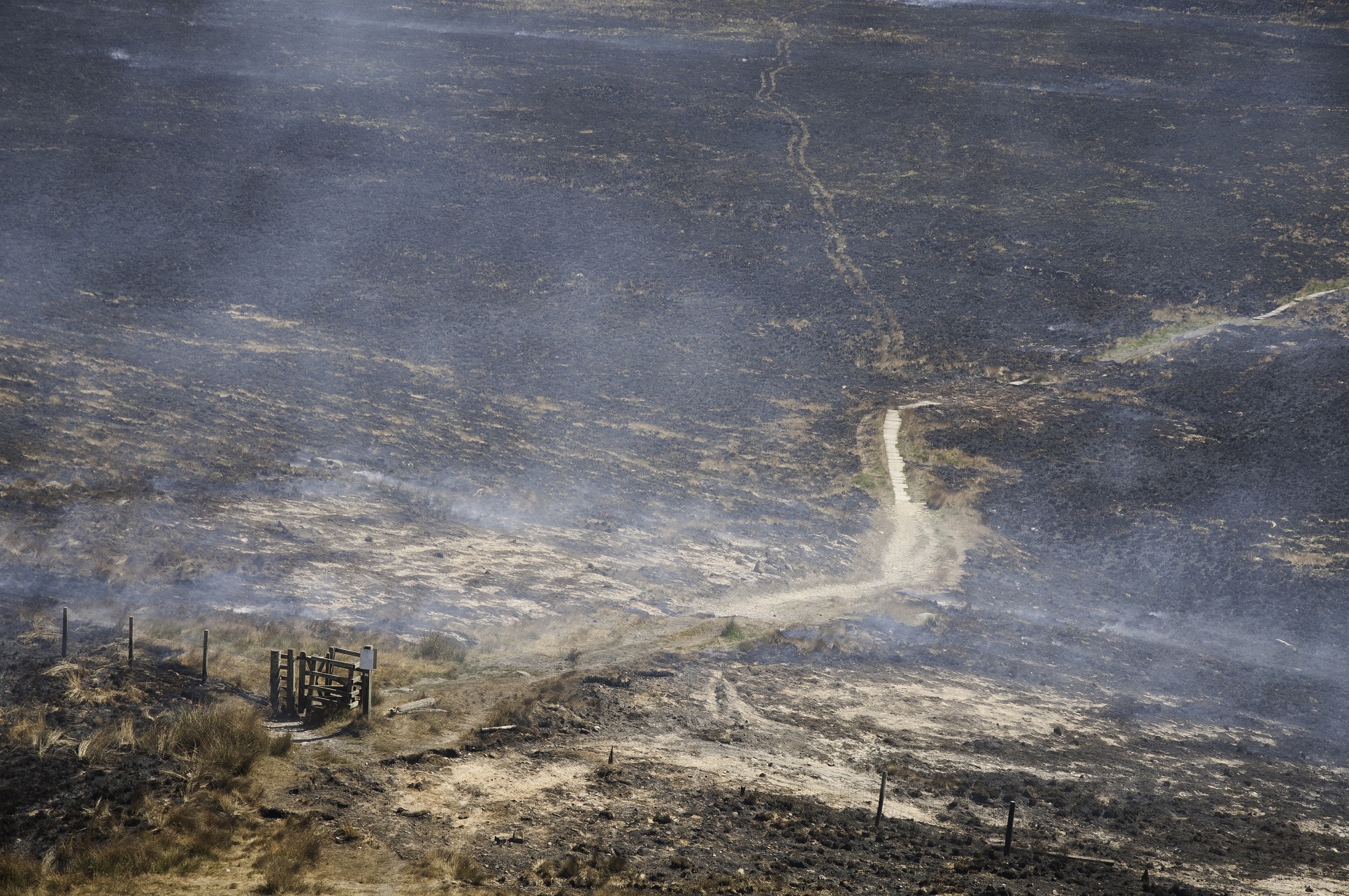 Charred embers on Rivington Moor
Charred embers on Rivington Moor
Although the immediate danger to the gardens had passed and many of the fire crews had been stood down, the situation along the Belmont Road was still precarious. As Briony and I watched, patches of the moorland not 100 metres from the fence spontaneously burst into flame. Where no vegetation remained around such ‘hot spots’ the strategy was to let them burn themselves out, which they invariably did. Of greater concern to Briony was a patch of smoking ground close by the fence that had grown in intensity while we had been talking. A quick phone call to the incident centre at Pike Cottage and within minutes a fire tender and crew of three fire fighters arrived. We observed as a tank of some 30 litres of water, carried on a firefighter’s back, was sprayed onto the smoking ground. The water boiled as it made contact with the earth and was absorbed or evaporated within less than a minute. The smoking however had subsided and the immediate danger was passed.
As I watched, patches of the moorland not 100 metres
from the fence spontaneously burst into flame
I asked Briony what was the priority for her and the Groundwork volunteers now the fire was under control. “We’ve been cutting down the trees that were damaged by the fire anyway,” she explained. “The fire has gone down so deep into the peat it has come up through the roots and killed the trees from below, so we’ve been cutting back to make a bigger fire break along the road. Because it is so dry one little ember jumping across could ignite the gardens.”
Several moorland fires around the Manchester region have been attended by approximately 200 firefighters from across the North of England, and have necessitated the deployment of helicopters as water bowsers and the mobilisation of 100 troops from the Fourth Battalion of the Royal Regiment of Scotland, meaning that the financial cost will be considerable. Of even greater concern is the cost to wildlife. At midsummer ground nesting birds such as Skylarks, Lapwings and Curlews would have had chicks in the nests. Briony estimated that something in the region 3000 birds may have been killed, their nesting habitat destroyed.
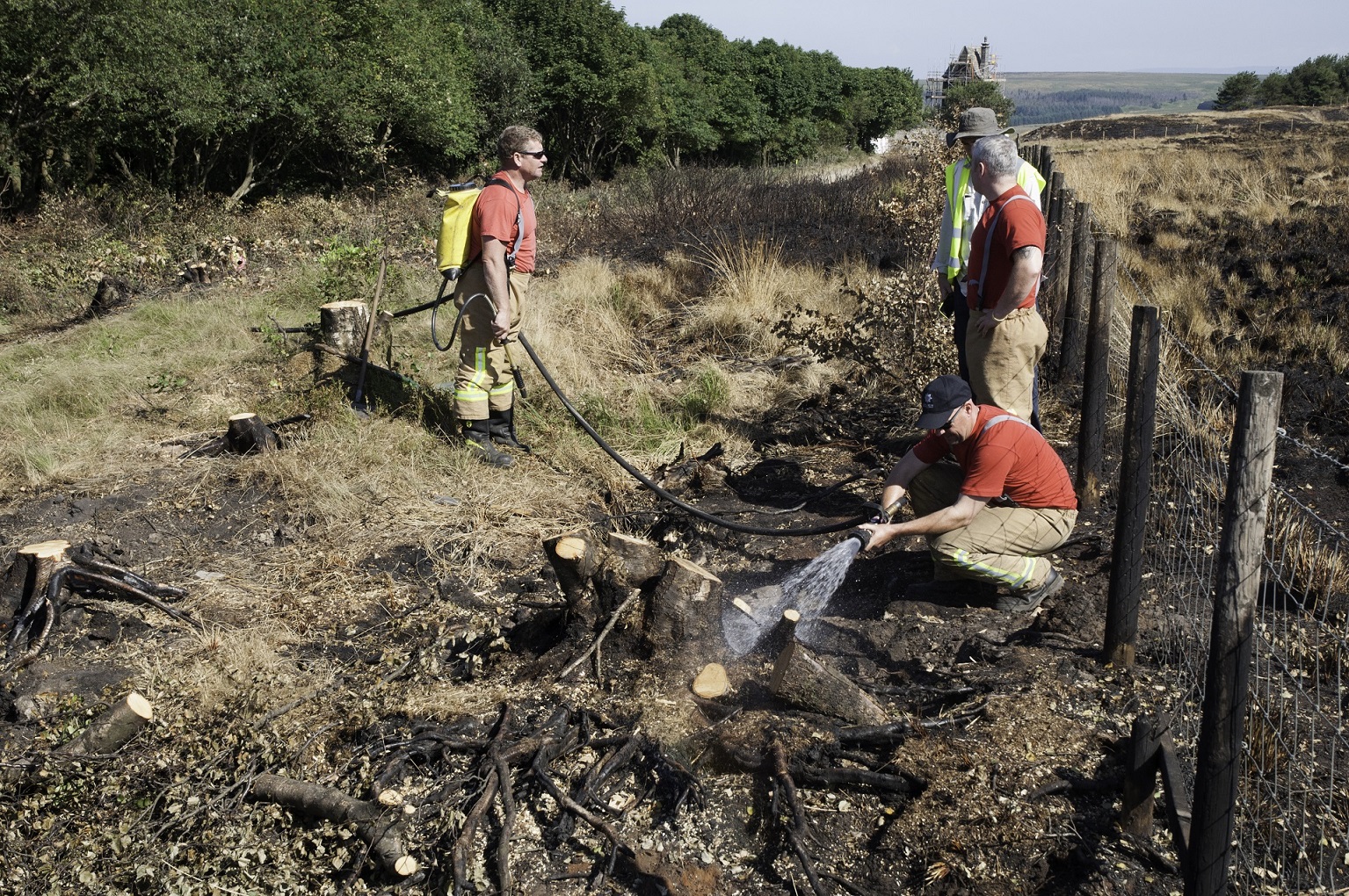 The firecrews deal with an overheating tree stump
The firecrews deal with an overheating tree stump
I asked Helen Thompson, Education Officer for the Rivington Heritage Trust, what the outlook was for recovery of the moor. “The heather may regenerate quite quickly,” she told me, “but we are looking at decades for the moor to get back to the level of biodiversity it had. In some areas the soil is burnt down to a depth of around three feet which means that the seed bank is sterilised.” Helen explained that the intense heat is likely to have cooked ground dwelling invertebrates, depleting the food supply of the surviving birds and small mammals, meaning they will either starve or migrate to areas not affected by the fire. A depleted food supply may also have an impact on the number of offspring breeding animals will be able to support.
“The fire has gone down so deep into the peat it has come up
through the roots and killed the trees from below”
Briony Jolley, Groundwork
As we spoke, a shout went up from Chris, one of the Groundwork volunteers. Two young Roe deer had approached the fence from the moorland side, trying to find a way to escape the scorched earth. “Maybe they can jump the fence,” suggested Chris.
But as we watched they became hesitant, trying to conceal themselves in what remained of the vegetation. Perhaps spooked by the present of vehicles and people on the road, with a kick of hind legs and a flash of white tail they fled, back out onto open moorland to find only the burnt remains of an ecosystem. “It’s like the kestrels,” said Chris. “I see them fly down in pairs from Rivington Pike. They circle around for a while but then they realise there’s nothing down here, and off they go.”
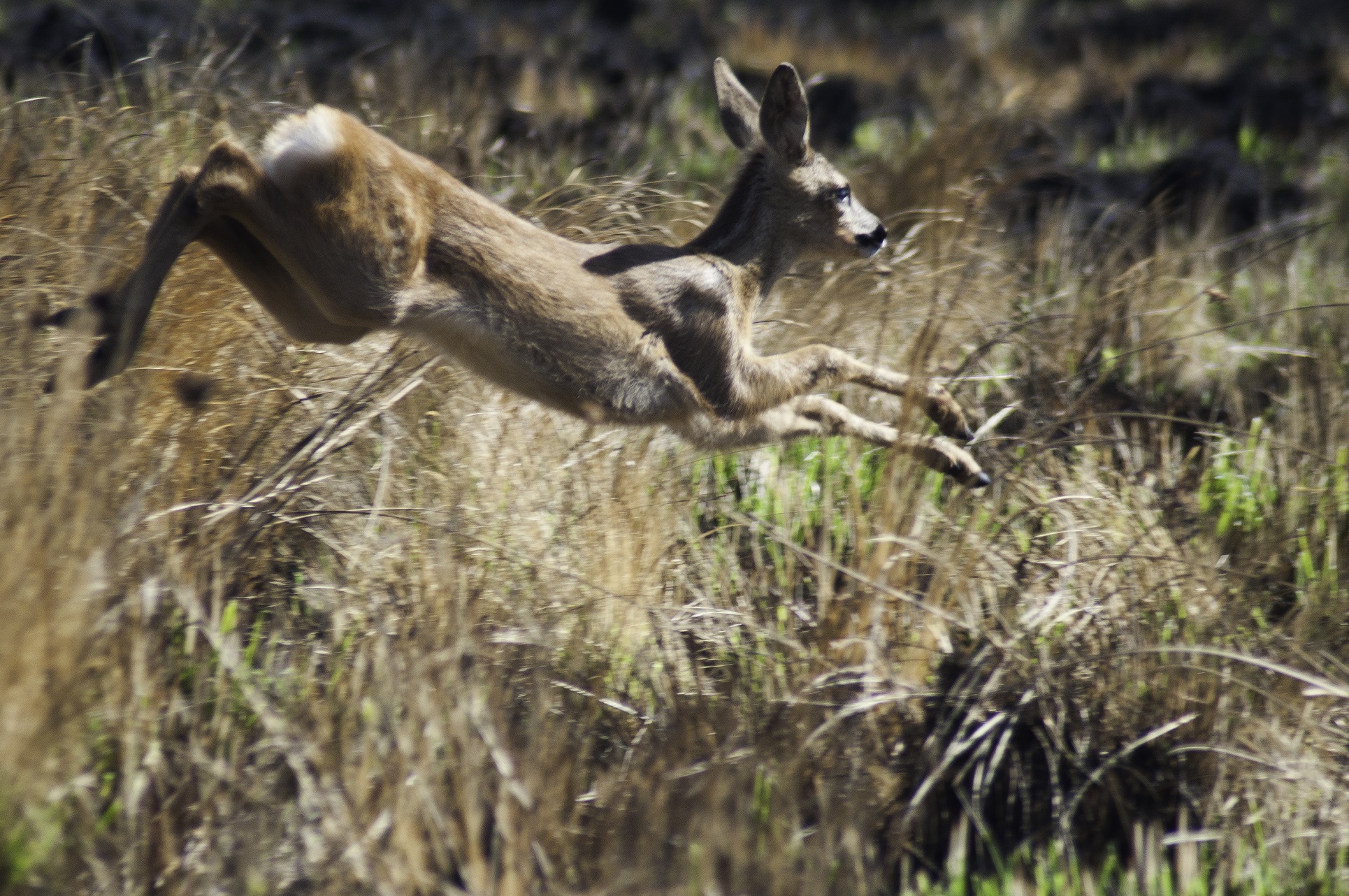 Roe deer trying to cross the fence into the gardens
Roe deer trying to cross the fence into the gardens
Greater Manchester Police suspect the cause of the Saddleworth fire was a bonfire lit on land close to Buckton Vale near the town of Stalybridge and that the Winter Hill fires were copycat incidents. A 20-year-old man from Wigan and a 22-year-old man from Bolton have been arrested on suspicion of arson. I asked Helen how she felt about the fires having been started deliberately. “It’s extremely disappointing,” she told me, “when you look at the devastation it has caused it is very frustrating, heartbreaking really. It’s such a massive area of this hillside that has been affected and so much wildlife and their habitat.”
The Groundwork team remains positive. The Rivington Terraced Gardens have, so far, been saved and the £4million restoration programme, funded partly by the National Lottery Heritage Fund and match funding from Rivington Heritage Trust, can continue. “We’re very grateful for the work of the emergency services,” Helen tells me, “and our fantastic volunteers for giving up their time, some even taking time off work to come and help us.”
“I see the kestrels fly down in pairs from Rivington Pike. They circle around for a
while but then they realise there’s nothing down here, and off they go.”
Chris, Groundwork volunteer
I joined the Groundwork volunteers as they took a well-earned break by the side of the Belmont Road, Helen passing round ice cold drinks from a cooler box stashed in the back of the van. We sat in a line with the gardens behind us looking out across the smouldering moorland. “What we really need is some rain,” says Chris, shading his eyes against the intense sunlight. Hopefully today’s downpours will extinguish these brutal fires once and for all.


